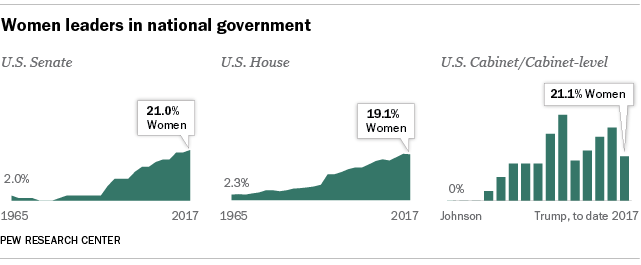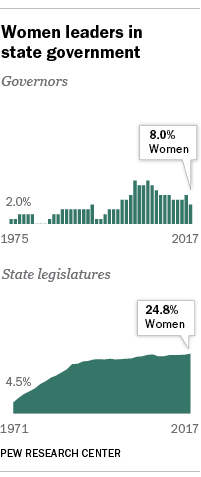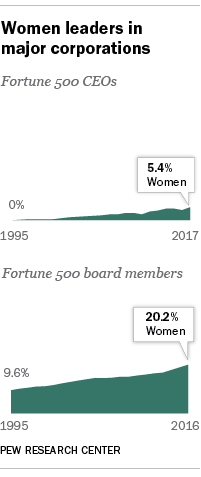Jeannette Rankin made history 100 years ago this year when she took office as the first female member of Congress. “I may be the first woman member of Congress, but I won’t be the last,” the Montana Republican predicted after winning election to the U.S. House of Representatives the year before.
Rankin was right: In the century since she began her service as a member of Congress, hundreds of women have followed in her footsteps. But women remain underrepresented in all major political offices and top business leadership positions in the United States.
In 2017, 21 women serve in the U.S. Senate and 83 serve in the House of Representatives, comprising 19.4% of Congress. While this share is nearly nine times higher than it was in 1965, it remains well below the 51.4% of women in the overall U.S. adult population. (An additional five women serve as nonvoting delegates in the House, representing American Samoa, the District of Columbia, Guam, Puerto Rico and the U.S. Virgin Islands.)

(See our updated interactive, “The Data on Women Leaders”)
Nancy Pelosi is the highest-ranking woman in congressional history, serving as House speaker from 2007 to 2011 and currently serving as the chamber’s minority leader. Her home state, California, has sent more women to Congress than any other state – a total of 41 as of 2017.

The share of women serving in state legislatures is slightly higher than at the national level. Some 24.8% of state legislators are women, up from 4.5% in 1971. This varies widely by state: Vermont has the largest share, with women making up 40.0% of the General Assembly, while Wyoming has the smallest share, 11.1%. Women also began serving in state office before they entered the national stage: Three women were elected to Colorado’s House of Representatives in 1894, 22 years before Rankin was elected and 26 years before the 19th Amendment was ratified, guaranteeing women across the country the right to vote. (Colorado legalized women’s suffrage in 1893.)
There are currently four women governors, representing Oklahoma, Oregon, New Mexico and Rhode Island, and a total of 37 women have served in this role since 1925. (One additional woman has served as governor in Puerto Rico.) The number of simultaneously serving female governors peaked at nine, or 18% of all state governors, in 2004 and again in 2007.
Four women are serving in Cabinet-level positions under President Donald Trump (21.1% of the positions that have been confirmed to date), a share about on par with George W. Bush’s Cabinet but smaller than in Barack Obama’s. The share of women in Cabinet or equivalent positions peaked at 40.9% during Bill Clinton’s second term. Seven women have served as labor secretary, more than in any other Cabinet-level position.

The share of Fortune 500 chief executives who are female remains very small, reaching a record 5.4% in the first quarter of 2017. Yet as recently as 1995, no Fortune 500 companies had women CEOs. Katharine Graham became the first female CEO on the Fortune 500 list in 1972, when she became head of The Washington Post Co. A recent study found that among the top 100 public companies by revenue, female CEOs are out-earning male CEOs, though there are only eight women on the list. Among all workers, on average, women continue to earn less than men.
Women are more widely represented on boards of Fortune 500 companies. Roughly one-in-five (20.2%) of these seats were held by women in 2016, up from 9.6% in 1995. Women are more likely than men to hold board seats at multiple companies, however, so the number of new women entering corporate leadership positions may not be increasing proportionately.
